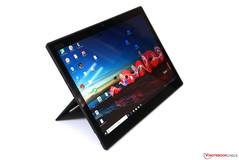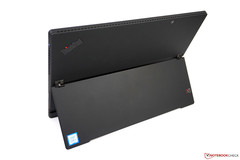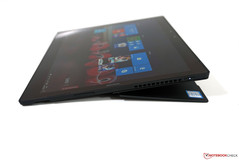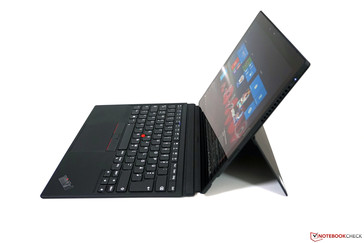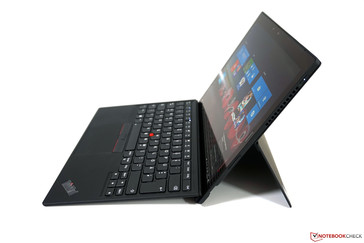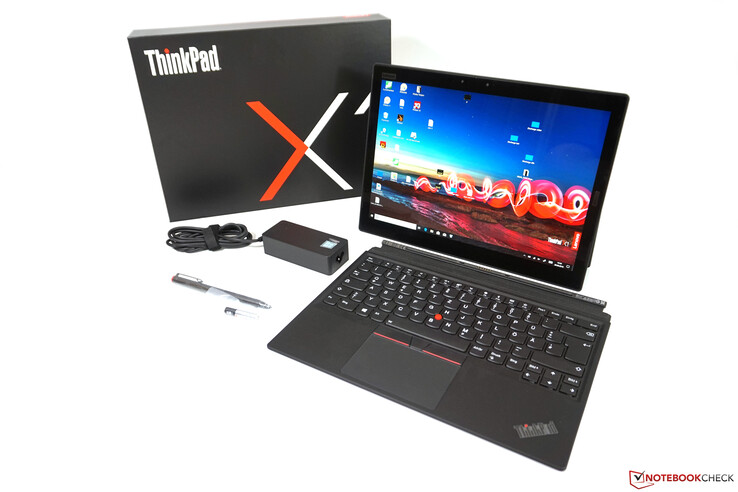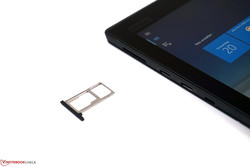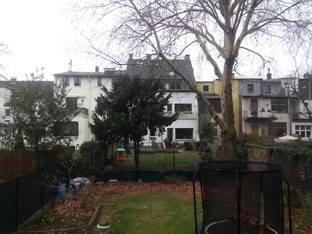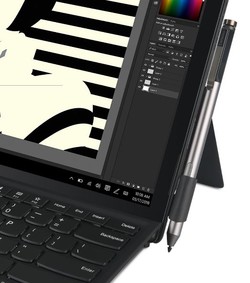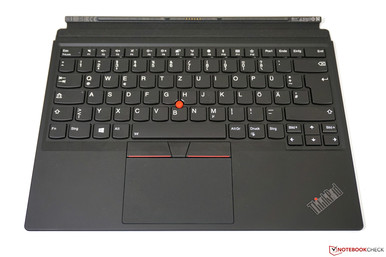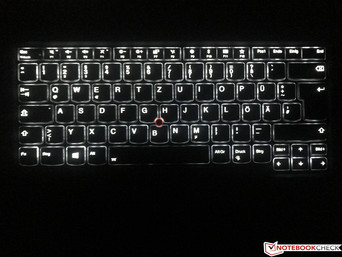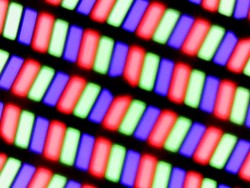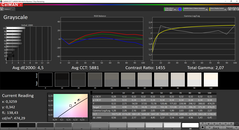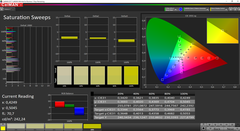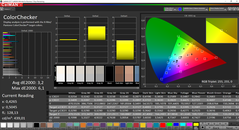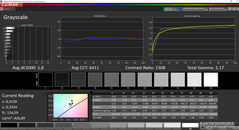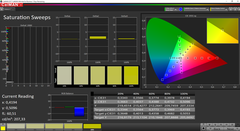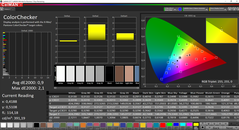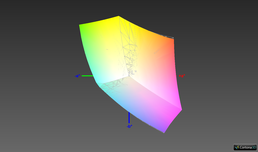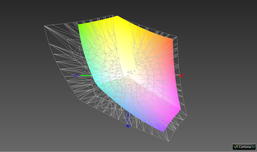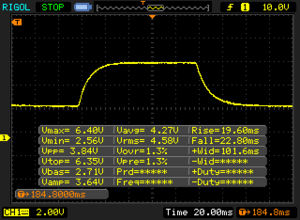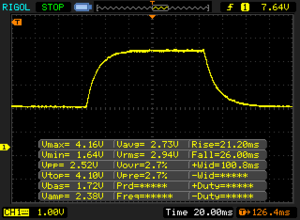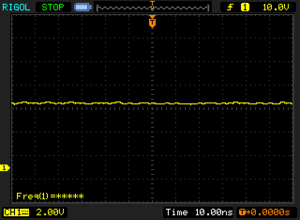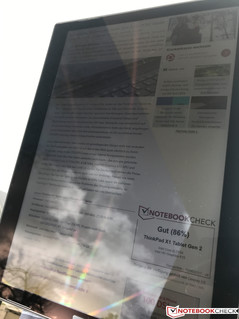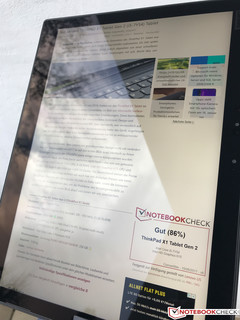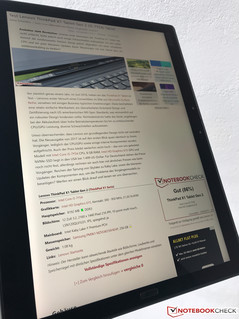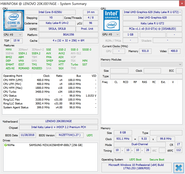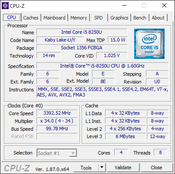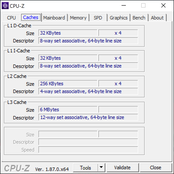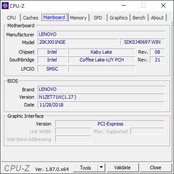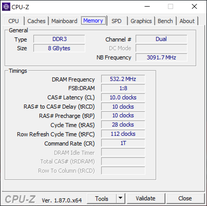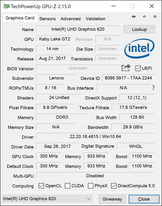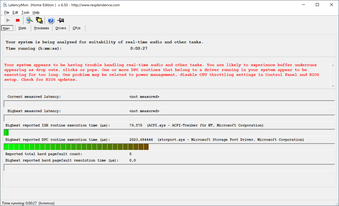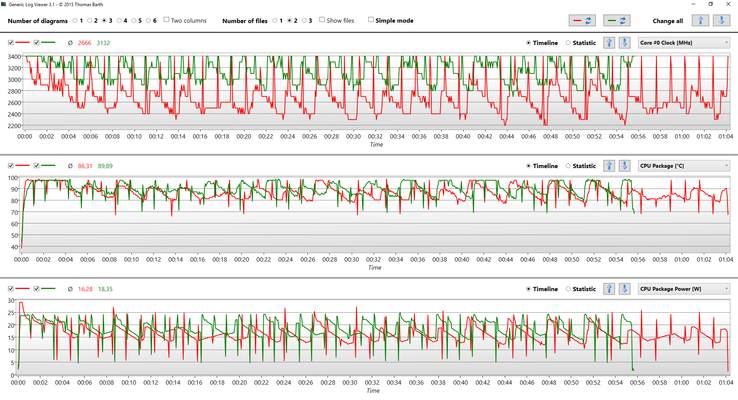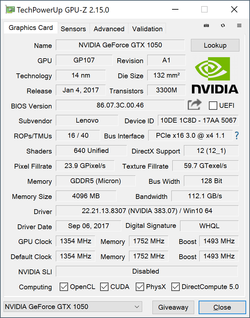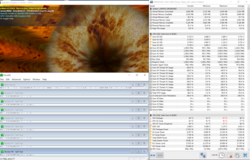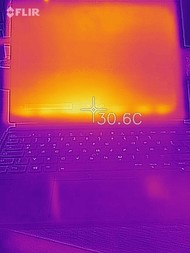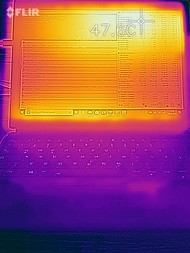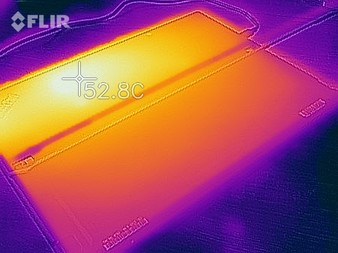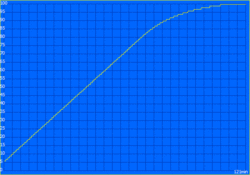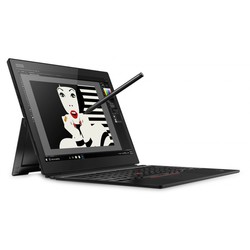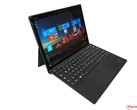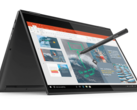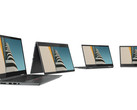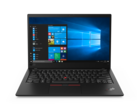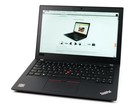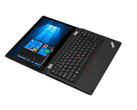Lenovo ThinkPad X1 Tablet 2018 (i5, 3K-IPS) Convertible Review
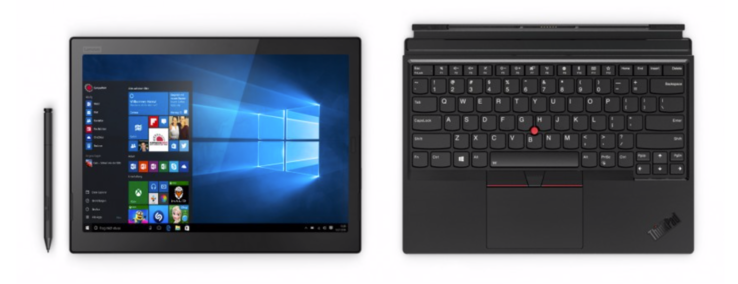
The ThinkPad X1 Tablet series has reached its third iteration and Lenovo has completely reworked the business convertible for this occasion. The tablet-laptop hybrid has grown from a 12-inch to 13-inch display size. The 3:2 aspect ratio has remained unchanged, but the new screen supports a resolution of 3,200 x 2,000 pixels. The other big change compared with older versions is the switch to more powerful 15 W ULV processors, which are used in most Ultrabooks these days. This means that unlike its two predecessors ThinkPad X1 Tablet Gen 1 and ThinkPad X1 Tablet Gen 2, the X1 Tablet Gen 3 includes a fan, since the quad-core CPUs require an active cooling system.
Lenovo offers many different configurations of the X1 Tablet Gen 3. For buyers of the ThinkPad, the processor, the RAM and the capacity of the SSD are configurable items. Also, there is an optional LTE module. In Germany, there are currently two models with a fixed configuration. Our review unit (20KJ001NGE) is sold for roughly €1,750 (~$1992 VAT included) and it contains an Intel Core i5, 8 GB of RAM and a 256 GB SSD. The more expensive model (20KJ001KGE) with a Core i7, 16 GB of RAM and a 512 GB SSD costs roughly €2,100 (~$2391 VAT included). These models are available as special educational models in Germany as well, which are exclusive to students or teachers and around €100 (~$114) cheaper. The most expensive model in Lenovo's German online store has a high price-tag of €2,700 (~$3074 VAT included). In Lenovo's US store, the most expensive model can be bought for $2,174 (VAT excluded). A model configured with the same components as our review unit costs $1,517 (VAT excluded).
Naturally, we are going to compare the new Lenovo ThinkPad X1 Tablet with its predecessors, but the other PC manufacturers also provide some interesting competition in the convertible business segment. Of course, the semi-professional Microsoft Surface Pro 6 is a well known device in this category, but other very good competitors include the Dell Latitude 5290, the HP Elite x2 and the Toshiba Portégé X30T-E. We have linked the reviews of the older ThinkPad X1 Tablet models below, as well as a special CPU comparison article, comparing the CPU performance the X1 Tablet Gen 3 with the Surface Pro 6 and the HP Elite x2:
Case
With its typical matte black design, the third generation of the ThinkPad X1 Tablet can be easily identified as a member of the ThinkPad X series. On the back of the tablet, Lenovo has placed the blacked-out ThinkPad logo with a red status LED as well as a small stylized "X1" logo. The front is dominated by the touchscreen and its protective Gorilla Glass casing. Unlike its predecessor, the separate plastic bezel beneath the screen is gone, but the screen bezels are still pretty wide by today's standards. Different from some tablets with purely metal casings, the X1 Tablet has no sharp edges and it rests comfortably in the hand.
The active cooling system necessitates some changes to the design. On the right side, there is now a fan exhaust and on the upper edge, there are some intakes. The kickstand has also been completely redesigned, it now works similar to the competitors. When the kickstand is opened, the hinges are pretty loose for the first few centimeters. The kickstand becomes stable only when an opening angle of roughly 30 degrees is reached. In the closed state, a magnet holds the kickstand to the chassis. The maximal opening angle is pretty big with about 165 degrees, which means that it is almost possible to open the kickstand all the way. On both sides of the case, there are two areas of recess, which make opening the kickstand easier.
The workmanship and stability of the tablet are very good. The case can only be twisted slightly by using a lot of force – twisting the case does not result in creaking-noises and it does not impact the image of the LCD panel. As with most ThinkPads, the X1 Tablet has been tested with military standard tests according to Lenovo, though the manufacturer does not specify which tests exactly. With our unit, the keyboard was included in the box. With a thickness of just 5 mm (~0.2 in), this piece of equipment is very slim, meaning that it is also much more flexible than the case of the tablet, though there was not any audible squeaking or creaking here either. The keyboard is connected to the tablet at the lower edge of the device via a pogo-pin connector and two small plastic hooks. Thanks to the magnetic connection, the keyboard is locked solidly into place and the tablet can be lifted without disconnecting the keyboard. When the X1 Tablet is not used, the keyboard can be flipped onto the screen, protecting the device while it is being transported.
The keyboard can be used in two positions: Flat on the table or slightly angled (see the pictures above), slightly reducing the overall footprint of keyboard and tablet together. This should also help when the hybrid is used on the lap. Using the X1 Tablet on the lap is not very comfortable though, as the tablet is pretty top-heavy, especially when the kickstand is opened too far. It should be noted though that this is a problem shared with pretty much all tablet convertibles of this type. Another problem is that the keyboard is very sensitive when it comes to dirt, grease and smudges in general – this is true of the palmrest as well as the back of the keyboard. After a short time of using the device, the keyboard does not look very nice anymore – it should be cleaned regularly.
Our specific configuration of the tablet itself weighs roughly 900 g (~2 lb), the keyboard adds an additional 379 g (~13 oz) to the whole package. With 1.279 kg (~2.82 lb), the X1 Tablet Gen 3 is heavier than its predecessor (1.1 kg/~2.4 lb), but the weight increase can be justified because of the faster CPU and the necessary active cooling system. Compared with the other convertible tablets, the X1 Tablet is one of the heaviest and biggest, which is due to the larger screen as well. We have also included the 2018 ThinkPad X1 Carbon in the size comparison, which is actually lighter than the X1 Tablet. For those planning to use the X1 Tablet most of the time with the keyboard attached, the slightly thicker X1 Carbon might be the more attractive option.
Connectivity - 2x Thunderbolt 3 on the X1 Tablet
The port selection has been revamped completely as well. Instead of a combination of one USB 3.1 Gen 1 type C and one USB 3.0 type A port, there are now two USB C ports, which support USB 3.1 Gen 2 as well as Thunderbolt 3 (with four PCIe lanes for both ports). One of the two is also used to charge the tablet, which means that it is practically always used. In a stationary usage scenario, the cable connected to the top of the tablet can be a bit annoying. The dedicated video-output has been removed too, connecting external displays is only possible via a USB C cable or adapter. On the left side of the device, there is a 3.5 mm headphone-jack as well as a Kensington-lock slot, which is compatible with the Kensington MiniSaver standard.
The implementation of the modern USB C ports with Thunderbolt 3 is certainly future-proofed and allows for the connection of many accessories. However, many older accessories will need an adapter. For now, a combination of USB C / Thunderbolt 3 and a USB A port would probably be more practical for most users. In this respect, both the Dell 5290 2-in-1 and the Toshiba Portégé (ports on the keyboard dock) have the advantage.
SD card-reader – MicroSD with UHS-I
As with many smartphones and Android tablets, Lenovo uses a combined slot for the NanoSim and MicroSD card. Both can be used at the same time, but to remove the cover, a small object such as a SIM tool or a needle is needed. This means that a quick exchange is not possible. The card-reader is rated to UHS I speed, so our reference card for benchmarking (Exceria Pro M501 UHS II) can not realize its full potential. The new ThinkPad X1 Tablet has a similarly fast card-reader as its predecessor and the Surface Pro 6, but the Dell Latitude 5290 has a much faster UHS II card-reader.
| SD Card Reader | |
| average JPG Copy Test (av. of 3 runs) | |
| Dell Latitude 5290 2-in-1 (Toshiba Exceria Pro M501 UHS-II) | |
| Lenovo ThinkPad X1 Tablet G3-20KJ001NGE (Toshiba Exceria Pro M501 UHS-II) | |
| Microsoft Surface Pro 6, Core i7, 512 GB (Toshiba Exceria Pro M501 microSDXC 64GB) | |
| Lenovo ThinkPad X1 Tablet Gen 2 (Toshiba Exceria Pro SDXC 64 GB UHS-II) | |
| Average of class Convertible (28.1 - 209, n=23, last 2 years) | |
| maximum AS SSD Seq Read Test (1GB) | |
| Dell Latitude 5290 2-in-1 (Toshiba Exceria Pro M501 UHS-II) | |
| Average of class Convertible (28.9 - 253, n=22, last 2 years) | |
| Lenovo ThinkPad X1 Tablet Gen 2 (Toshiba Exceria Pro SDXC 64 GB UHS-II) | |
| Microsoft Surface Pro 6, Core i7, 512 GB (Toshiba Exceria Pro M501 microSDXC 64GB) | |
| Lenovo ThinkPad X1 Tablet G3-20KJ001NGE (Toshiba Exceria Pro M501 UHS-II) | |
Communication - ThinkPad tablet with LTE
Lenovo offers only a single WLAN module for the third generation of the X1 Tablet, which we already know from many other business laptops. The Intel Wireless AC 8265 may not be the latest WLAN card from Intel, but it is a solid choice. Apart from the usual WLAN standards including the fast 802.11ac, it also supports Bluetooth 4.2. In our standardized test with the router Linksys EA8500, the performance while receiving data was very good, although we have seen better results when it comes to sending data. Everyday-use is unlikely to be impacted and the performance is comparable to normal Ultrabooks.
Our review unit also contains a WWAN modem (Qualcomm Snapdragon X7) with GPS. When the unit is configured in the Lenovo store, the LTE modem costs €140 or $106. In the hardware maintenance manual (see the maintenance chapter), Lenovo describes how to access the WWAN modul, but this requires a lot of work to take the device apart. Also, Lenovo does not count the WWAN card as a CRU, meaning it is not a component that users should exchange by them self. Furthermore, it is doubtful if the antennas are there if the device did not come with WWAN ex-factory.
With a NanoSIM, it is possible to access the Internet on the go without a WiFi connection or phone tethering, which can be of great use depending on user priorities. The competitors from Dell, HP and Toshiba also offer this capability, only Microsoft still has issues with implementing LTE into their machines.
The X1 Tablet has two camera modules, one with 2.0 MP on the front and one with 8.0 MP on the back (which includes a flash as well as auto-focus). For both cameras, a bright environment is important. Low-light conditions do result in visible grain. When the conditions are good, the camera on the back can be used to take some good enough looking pictures, but the front-camera disappoints in every respect. It is fine for video conferencing, but the quality is definitively lacking.
Security
The X1 Tablet has the security features one would expect from a ThinkPad. Apart from a TPM chip and a SSD with OPAL 2.0 support, various passwords can be set in the UEFI-BIOS (e.g. Boot, BIOS). On the front of the device, there is also an Infrared camera, which enables fast log-in with Windows Hello. This is not the only possible way to log-in via a biometric feature, as Lenovo integrates a fingerprint-reader on the right side of the screen bezel as well. This reader is touch-based and works mostly well, although it occasionally does not recognize the fingerprint at the first try – this is possibly due to the rather slim reader.
Accessories – ThinkPad Pen Pro is included
The box contents of the ThinkPad X1 Tablet are rather plentiful, since not only it includes the keyboard, but also the ThinkPad Pen Pro. This pen offers 2,048 levels of pressure sensitivity and it is running on AAAA batteries. Optionally, there also is a Lenovo Pen Pro, which offers 4,096 levels of pressure-sensitivity and a tilt-angle function for shadows – this pen can be recharged via USB C. Unfortunately, neither pen can be stored inside of the case of the X1 Tablet and there is also no magnetic holder. Optionally, Lenovo offers a pen-holder that can be attached to the right side of the chassis. That this small plastic part is not included is strange in our opinion.
Thanks to the USB C ports with Thunderbolt 3, many accessories will work with the ThinkPad X1 Tablet. Of special interest are docking-stations, which can be connected to the X1 Tablet in the office or at home. We have tried out the Lenovo Thunderbolt 3 graphics dock and after the installation of the right driver, the connection worked as it should, including the dedicated GeForce GTX 1050. Further details about this test are included in our section about the performance of the X1 Tablet.
Maintenance
In general, users can open up their ThinkPad X1 Tablet, as the chassis is not glued or soldered. In the official Hardware Maintenance Manual by Lenovo, the manufacturer describes how to open the device and how to access the components (such as the Wi-Fi module or the battery). It should be noted though that these parts are not CRUs, meaning that they are not meant to be replaced by the customer, and only by Lenovo's official service. Taking out parts on your own can risk the warranty if the device becomes defective after tampering with the insides.
Warranty
In Germany, both the pre-configured and the configurable models have a three year warranty with bring-in service as their standard warranty (with the battery only being covered for one year). Bring-in means that the customer has to mail in a defective unit. In the US, some units have a three year warranty, others only have a one year warranty standard – buyers of the X1 Tablet should be on the lookout for that. Optionally, Lenovo offers extensive warranty extensions, with a maximum warranty duration of 5 years. Extra services can include accidental damage protection as well as a three year battery warranty. Please see our Guarantees, Return policies and Warranties article for country-specific information.
Input devices – X1 Tablet with folio keyboard
Keyboard
Thanks to the larger screen, Lenovo has been able to incorporate a larger keyboard as well. The width of the keyboard is now identical to that of the normal ThinkPad X1 Carbon and its typing feel is also pretty much the same. This means a rather large key-travel for such a slim device, ample feedback and a precise pressure-point. For someone who has to type in long texts, this keyboard is a joy – though only when the keyboard lays flat on the table. When the keyboard is angled to the tablet or when using it on the lap, the keyboard does have a lot of flex, which impacts the typing experience in a bad way. The slim folio keyboard just cannot provide the same stability as a regular laptop.
The keyboard is backlit and offers two stages of intensity. It can be activated manually as well as automatically. Since there are only two stages, it is very noticeable when the system changes the brightness, but the feature is definitely useful.
Touchpad, TrackPoint & touchscreen
The mouse-pointer can be controlled either with the touchpad or the TrackPoint. Both are identical to the input-devices of the ThinkPad X1 Carbon as well, allowing for a problem-free input. Both the ClickPad and the buttons of the TrackPoint offer a deep and at the same time quiet feedback.
Of course, the touchscreen can be used as an alternative method of input as well. As one would expect from a capacitive touchscreen, up to ten fingers are recognized fast and without any problems. The pen input also worked very well in our test, although the standard pen does seem a bit small for larger hands.
Display - X1 Tablet with 3K touchscreen
With the third generation of the ThinkPad X1 Tablet, the screen-size has increasedfrom 12 to 13 inches. At the same time, the resolution has increased from 2,160x1,440 (2K) to 3,000x2,000 (3K). The aspect ratio of 3:2 has stayed the same, which is why the screen offers more vertical space than comparable 16:9 panels. For productive use-cases such as Microsoft Excel, this screen is better suited thanks to its aspect ratio.
In our review unit, the LCD was made by LG (LP130QP1-SPA1). Lenovo advertises this screen with a brightness-value of 400 cd/m² and our measurements confirm that the screen reaches this value. In the middle of screen, we even measure 470 cd/², but the LCD is far less bright on the right side of the panel. This means that the average brightness exceeds the advertised value, but the brightness-distribution of 76% is pretty middling. In real-life usage, this effect is pretty minimal and only slightly visible when the screen shows completely a single color. Still, we would have appreciated a better brightness distribution, especially at this price level.
The black-value is good, resulting in a very good contrast-ratio of 1,400:1. This leads to saturated colors, the overall picture has a slightly warm color tint. Unlike the preceding model, PWM is not used here to regulate the screen brightness, which can be set to automatically adjust to the brightness of the environment, thanks to the brightness sensor. Despite the high brightness, there is only a little screen bleeding at the lower edge of the screen, which is only visible when very dark screen-content is shown.
| |||||||||||||||||||||||||
Brightness Distribution: 76 %
Center on Battery: 470 cd/m²
Contrast: 1436:1 (Black: 0.33 cd/m²)
ΔE ColorChecker Calman: 3.2 | ∀{0.5-29.43 Ø4.77}
calibrated: 0.9
ΔE Greyscale Calman: 4.5 | ∀{0.09-98 Ø5}
99.4% sRGB (Argyll 1.6.3 3D)
64% AdobeRGB 1998 (Argyll 1.6.3 3D)
69.3% AdobeRGB 1998 (Argyll 3D)
99.1% sRGB (Argyll 3D)
68.1% Display P3 (Argyll 3D)
Gamma: 2.07
CCT: 5881 K
| Lenovo ThinkPad X1 Tablet G3-20KJ001NGE LP130QP1-SPA1, , 3000x2000, 13" | HP Elite x2 1013 G3-2TT14EA AU Optronics AUO101A, , 3000x2000, 13" | Microsoft Surface Pro 6, Core i7, 512 GB LGPhilips LP123WQ112604, , 2736x1824, 12.3" | Dell Latitude 5290 2-in-1 SHP1479, , 1920x1280, 12.3" | Toshiba Portege X30T-E-109 Toshiba TOS508F, , 1920x1080, 13.3" | Lenovo ThinkPad X1 Tablet Gen 2 LSN120QL01L01, , 2160x1440, 12" | |
|---|---|---|---|---|---|---|
| Display | -2% | -3% | 2% | -5% | ||
| Display P3 Coverage (%) | 68.1 67.8 | 67.5 -1% | 67.1 -1% | 70.5 4% | 67.2 -1% | |
| sRGB Coverage (%) | 99.4 99.1 | 96.7 -3% | 95.5 -4% | 98.6 -1% | 90.8 -9% | |
| AdobeRGB 1998 Coverage (%) | 69.9 69.3 | 68.2 -2% | 67.9 -3% | 71.5 2% | 66.5 -5% | |
| Response Times | 20% | 25% | -3% | 12% | 43% | |
| Response Time Grey 50% / Grey 80% * (ms) | 47.2 ? | 47 ? -0% | 43 ? 9% | 56.8 ? -20% | 42 ? 11% | 28.4 ? 40% |
| Response Time Black / White * (ms) | 42.4 ? | 26 ? 39% | 25 ? 41% | 36 ? 15% | 37 ? 13% | 22.8 ? 46% |
| PWM Frequency (Hz) | 22000 ? | 1852 ? | 17000 ? | 221.2 ? | ||
| Screen | -18% | -5% | -16% | -39% | -23% | |
| Brightness middle (cd/m²) | 474 | 452 -5% | 484 2% | 548 16% | 350 -26% | 388.1 -18% |
| Brightness (cd/m²) | 418 | 412 -1% | 473 13% | 545 30% | 343 -18% | 344 -18% |
| Brightness Distribution (%) | 76 | 85 12% | 91 20% | 86 13% | 73 -4% | 78 3% |
| Black Level * (cd/m²) | 0.33 | 0.48 -45% | 0.33 -0% | 0.51 -55% | 0.29 12% | 0.39 -18% |
| Contrast (:1) | 1436 | 942 -34% | 1467 2% | 1075 -25% | 1207 -16% | 995 -31% |
| Colorchecker dE 2000 * | 3.2 | 4.05 -27% | 4.29 -34% | 3.65 -14% | 6.36 -99% | 4.6 -44% |
| Colorchecker dE 2000 max. * | 6.1 | 6.64 -9% | 6.46 -6% | 7.15 -17% | 11.63 -91% | 9.1 -49% |
| Colorchecker dE 2000 calibrated * | 0.9 | 1.56 -73% | 1.34 -49% | 1.81 -101% | 1.7 -89% | |
| Greyscale dE 2000 * | 4.5 | 4.87 -8% | 4.3 4% | 5.5 -22% | 8.04 -79% | 6.1 -36% |
| Gamma | 2.07 106% | 2.71 81% | 2.51 88% | 2.154 102% | 2.47 89% | 2.07 106% |
| CCT | 5881 111% | 7160 91% | 7315 89% | 7052 92% | 7716 84% | 7104 91% |
| Color Space (Percent of AdobeRGB 1998) (%) | 64 | 62 -3% | 62 -3% | 65.2 2% | 59 -8% | 59 -8% |
| Color Space (Percent of sRGB) (%) | 99.4 | 97 -2% | 95 -4% | 99.1 0% | 91 -8% | 91 -8% |
| Total Average (Program / Settings) | 0% /
-10% | 6% /
-1% | -6% /
-11% | -11% /
-26% | 10% /
-12% |
* ... smaller is better
Our additional measurements with an X-Rite i1 Pro2 spectrophotometer confirm the warm, slightly yellow tint of the picture. The average DeltaE 2000 deviations compared to the sRGB color gamut are OK for a business convertible even without a calibration. There are only a few outliers, especially when it comes to the colors.
A calibration does still pay off, especially if photo-editing is a use case. Because of the nearly complete coverage of sRGB, photo editing is possible, as all the measured color values are as they should be after the calibration (average: 0.9) – a very good result. The color-temperature and tint was corrected with the calibration as well. As always, our calibrated ICC profile is available to download for free in the box above.
Especially for a tablet, it is important that the content of the screen is visible from all directions. Thanks to the IPS panel, this is not a problem for the X1 Tablet. Lenovo also offers an optional privacy-filter for this screen, which can be especially useful on the go.
Display Response Times
| ↔ Response Time Black to White | ||
|---|---|---|
| 42.4 ms ... rise ↗ and fall ↘ combined | ↗ 19.6 ms rise | |
| ↘ 22.8 ms fall | ||
| The screen shows slow response rates in our tests and will be unsatisfactory for gamers. In comparison, all tested devices range from 0.1 (minimum) to 240 (maximum) ms. » 98 % of all devices are better. This means that the measured response time is worse than the average of all tested devices (20.2 ms). | ||
| ↔ Response Time 50% Grey to 80% Grey | ||
| 47.2 ms ... rise ↗ and fall ↘ combined | ↗ 21.2 ms rise | |
| ↘ 26 ms fall | ||
| The screen shows slow response rates in our tests and will be unsatisfactory for gamers. In comparison, all tested devices range from 0.165 (minimum) to 636 (maximum) ms. » 81 % of all devices are better. This means that the measured response time is worse than the average of all tested devices (31.6 ms). | ||
Screen Flickering / PWM (Pulse-Width Modulation)
| Screen flickering / PWM not detected | |||
In comparison: 53 % of all tested devices do not use PWM to dim the display. If PWM was detected, an average of 8081 (minimum: 5 - maximum: 343500) Hz was measured. | |||
We arrive now at probably the biggest problem of the screen, its glossy surface. This helps to improve the overall picture quality, but it has a very negative impact on the usability on the outside or in other bright environments. When the sky is cloudy, the brightness suffices to make the display somewhat usable, but it is not bright enough to combat the sun. For consumer-oriented models, glossy panels are the standard, but we would have hoped that a business-oriented models such as the X1 Tablet would offer a matte option.
Performance – quad-core in the X1 Tablet
Lenovo offers different configurations of the ThinkPad X1 Tablet, although all models share the core-specifications: A newer quad core ULV processor by Intel, a fast PCIe SSD and at least 8 GB of RAM. This means that the performance of the convertible is comparable to normal business laptops and Ultrabooks and every model of the X1 Tablet should be well-suited for office-use. Unfortunately, buyers do not get a completely free choice when it comes to CPU and RAM. Both Core i5 options are only available with 8 GB of RAM and the Core i7-8550U is only offered with 16 GB of RAM. Only the Core i7-8650U is available with both options. Apart from the different clock-speed, the CPUs are also differentiated by the availability of vPro, which only the Core i5-8350U and Core i7-8650U offer. This feature is mostly interesting for larger enterprise customers.
The tool LatencyMon shows that the X1 Tablet has problems with real-time audio, regardless of whether Wi-Fi was activated or not. According to the tool, a Microsoft storage driver was responsible for this problem.
Processor - i5 faster than i7
Our review unit of the ThinkPad X1 Tablet is equipped with the most affordable CPU option, the Intel Core i5-8250U. This processor offers four native cores (base-clock 1.6 GHz, turbo-boost 3.4 GHz) and it supports hyper-threading. Additional technical information about this Kaby Lake Refresh processor are available in our tech-section.
As with many other recent ThinkPads, Lenovo has increased the TDP limit. Instead of 15 W, the CPU can consume 29 W indefinitely, which quickly becomes too much of a burden for the cooling system. In the CPU benchmarks, the machine still reaches very respectable results. We also had the opportunity to test the X1 Tablet with the optional i7 processor, but this CPU was just 3 % faster in the multi-core test. All other units with an i7, including the Surface Pro 6, are slower. The difference compared to the older X1 Tablet with a passively cooled Core m CPU is especially big.
The CPU performance is not lowered when the device is running on battery-power.
With our Cinebench multicore loop, we test how much performance can be expected after a long time of load. Slim devices in particular often have problems keeping up their high turbo-boost clock-speed. The results are pretty surprising: The X1 Tablet with i5 CPU loses some performance after the first iterations and its performance starts to fluctuate. After 50 iterations, the X1 Tablet with i5 has an average score of 550 points. Only the Surface Pro 6 with i7 performs better under permanent load (570 points average). Meanwhile, the X1 Tablet with the Core i7 has to contend with higher temperatures and thus only achieves an average score of 440 points, which means that it loses 1/3 of its CPU performance. This means that the i7 CPU upgrade does not pay off in a higher CPU performance at all and is not recommended.
We managed to increase the performance by decreasing the core voltage of the CPU. With our review-unit's Core i5-8250U, a stable operation was possible with -0.115 mV. For more details on how to do this, we redirect you to this detailed tech-article about undervolting. The processor now requires less power and produces less heat, even at the turbo-boost frequency of 3.4 GHz for all four cores (24 W). Because of the high core-temperatures, performance still fluctuates, but after 50 iterations of the Cinebench loop, the undervolted X1 Tablet achieved an average score of 640 points and the CPU needed 10 minutes less for the same task (~55 instead of ~65 minutes).
In the following diagram, we have put the results of the out-of-box X1 Tablet and the undervolted X1 Tablet over one another. The CPU becomes warmer and consumes more energy, but works with a roughly 500 MHz higher clock-speed.
System performance
Subjectively, there is nothing to complain about when it comes to the system performance of the X1 Tablet. The system boots up quickly, executes commands fast and applications are started fast thanks to the SSD. We did not encounter any problems with drivers or programs in our test. Lenovo bundles many settings into the Vantage app, for example for the energy management or Lenovo-specific driver updates.
In the synthetic benchmarks, there are some differences depending on which test is used. In the older PCMark 8, the higher resolution in particular impacts the results adversly. In the Work-test, the review unit lags behind the competition, though it is better than any competitor in the Creative- and Home-test. In the newer PCMark 10, the X1 Tablet finds itself in a mid-table position, although all compared tablet convertibles are very close. Also, there is no noticeable difference in real-world usage.
| PCMark 8 Home Score Accelerated v2 | 3479 points | |
| PCMark 8 Creative Score Accelerated v2 | 4767 points | |
| PCMark 8 Work Score Accelerated v2 | 4136 points | |
| PCMark 10 Score | 3544 points | |
Help | ||
Storage – PCIe x4 SSD
Lenovo offers the ThinkPad X1 Tablet exclusively with fast M.2 NVMe SSDs. These SSDs are connected via PCIe x4, so there is no limitation there. As a customer, you can only choose the capacity: 256 GB, 512 GB or 1 TB. The cost of upgrading to 512 GB for €130 (~$148) in particular is reasonable, though a 1 TB drive costs a less reasonable €430 more. Lenovo often uses Samsung SSDs for its expensive X series ThinkPads, but sometimes, flash-drives from other manufacturers (such as Intel) are also used.
Our unit contains the 256GB version of the Samsung PM961 (210 GB free out of the box), which does not disappoint in the benchmarks. While reading data, this drive reaches sequential transfer-rates of more than 3,000 MB/s, although the performance is not as high while writing date (1,200 MB/s). That is because of the capacity, the drives with 512 GB or 1 TB reach higher values while writing data. All convertibles in our comparison are equipped with fast PCIe SSDs, so there is no noticeable difference in performance. For additional benchmarks and comparisons with other drives, we redirect you to our comprehensive SSD/HDD list.
GPU – X1 Tablet only with iGPU
The compact chassis of the X1 Tablet offers no space and not enough cooling-capability for a dedicated GPU. That is why the graphics output is managed by the integrated UHD Graphics 620 of the Intel CPU. Combined with the Core i5-8250U, its maximal core-speed reaches 1,100 MHz, which is a little bit less than the other offered CPUs. This GPU does not have its own dedicated memory, which means that it relies on the main system memory. In the case of the ThinkPad X1 Tablet, the GPU benefits from the dual-channel configuration of the RAM, as it can realize its full potential. More technical details about the Intel UHD Graphics are available here.
In the synthetic GPU test, the review unit performed very well, earning it a top-spot in the comparison with the other convertible tablets. It should be clear though that the CPU performance is not enough for modern games. Instead, the UHD Graphics 620 performs best in everyday multimedia usage, including the playback of high-resolution video. Depending on the used codec (QuickSync), a little bit of video-editing is no problem as well.
While operating on battery-power, the performance of the GPU is not reduced. Additional benchmark comparisons are possible with our GPU benchmark table.
| 3DMark 11 Performance | 2041 points | |
| 3DMark Cloud Gate Standard Score | 8625 points | |
| 3DMark Fire Strike Score | 1103 points | |
Help | ||
Gaming performance
As already mentioned in the GPU section: The performance of the integrated UHD Graphics 620 only suffices for older or casual titles. But even then, the resolution and graphical details may have to be lowered. Two examples are "Bioshock Infinite" as well as the popular "Rocket League", both are only playable on low details. Most casual games from the Windows Store should run fine on the X1 Tablet, but the performance simply is not there for more demanding titles such as "Witcher 3".
Our GPU gaming list shows which other games are playable with the UHD Graphics 620.
| low | med. | high | ultra | |
|---|---|---|---|---|
| BioShock Infinite (2013) | 59.2 | 34.8 | 30.2 | 10.1 |
| The Witcher 3 (2015) | 12.1 | |||
| Rocket League (2017) | 59.2 | 35.1 | 23.1 |
Lenovo Thunderbolt 3 Graphics Dock – Nvidia GeForce GTX 1050
Thanks to the Thunderbolt 3 ports, the X1 Tablet offers the possibility to connect an external GPU. Lenovo offers its Thunderbolt 3 graphics dock (~€400/~$455) for this very use case, which combines a docking-station with a dedicated GeForce GPU. The graphical output can either happen with an external monitor or (as in the following benchmarks) with the internal screen. In this case, Nvidia Optimus is supported, which means that the dGPU turns on automatically when it is needed. The GPU is the laptop-version of the GeForce GTX 1050 with 4 GB of GDDR5-VRAM.
| 3DMark 11 | |
| 1280x720 Performance | |
| Lenovo ThinkPad X1 Tablet G3-20KJ001NGE | |
| Lenovo ThinkPad X1 Tablet G3-20KJ001NGE | |
| 1280x720 Performance GPU | |
| Lenovo ThinkPad X1 Tablet G3-20KJ001NGE | |
| Lenovo ThinkPad X1 Tablet G3-20KJ001NGE | |
| 1280x720 Performance Physics | |
| Lenovo ThinkPad X1 Tablet G3-20KJ001NGE | |
| Lenovo ThinkPad X1 Tablet G3-20KJ001NGE | |
| 3DMark | |
| 1920x1080 Fire Strike Score | |
| Lenovo ThinkPad X1 Tablet G3-20KJ001NGE | |
| Lenovo ThinkPad X1 Tablet G3-20KJ001NGE | |
| 1920x1080 Fire Strike Graphics | |
| Lenovo ThinkPad X1 Tablet G3-20KJ001NGE | |
| Lenovo ThinkPad X1 Tablet G3-20KJ001NGE | |
| 1920x1080 Fire Strike Physics | |
| Lenovo ThinkPad X1 Tablet G3-20KJ001NGE | |
| Lenovo ThinkPad X1 Tablet G3-20KJ001NGE | |
In the synthetic benchmarks, the dedicated GPU is much better as could be expected. In the old 3DMark 11, the GTX 1050 achieves three times as many points and in the recent 3DMark FireStrike test, the difference is even bigger. At the same time, the physics result also benefits, which means that the CPU can perform better with the dock attached as well. This is because without the integrated GPU, the CPU has more leeway.
The performance boost is also quite noticeable in the gaming tests. The aforementioned titles "Bioshock Infinite" and "Rocket League" are now playable with high-details and FHD resolution with no problems. For more demanding titles, the GPU should be fast enough for mid to high details and FHD as well. "Witcher 3" for example runs with roughly 30 FPS at high settings. Despite its slight drop in performance due to high temperatures, the CPU does not limit the gaming performance even after long sessions, which is proven by our load-test with "Witcher 3" at high-settings. If someone wants to play games with the X1 Tablet and needs a docking-station anyway, the Thunderbolt 3 graphics dock from Lenovo seems like a good option.
| BioShock Infinite | |
| 1920x1080 Ultra Preset, DX11 (DDOF) | |
| Lenovo ThinkPad X1 Tablet G3-20KJ001NGE | |
| Lenovo ThinkPad X1 Tablet G3-20KJ001NGE | |
| 1366x768 High Preset | |
| Lenovo ThinkPad X1 Tablet G3-20KJ001NGE | |
| Lenovo ThinkPad X1 Tablet G3-20KJ001NGE | |
| 1366x768 Medium Preset | |
| Lenovo ThinkPad X1 Tablet G3-20KJ001NGE | |
| Lenovo ThinkPad X1 Tablet G3-20KJ001NGE | |
| 1280x720 Very Low Preset | |
| Lenovo ThinkPad X1 Tablet G3-20KJ001NGE | |
| Lenovo ThinkPad X1 Tablet G3-20KJ001NGE | |
| Rocket League | |
| 1920x1080 High Quality AA:High FX | |
| Lenovo ThinkPad X1 Tablet G3-20KJ001NGE | |
| Lenovo ThinkPad X1 Tablet G3-20KJ001NGE | |
| 1920x1080 Quality AA:Medium FX | |
| Lenovo ThinkPad X1 Tablet G3-20KJ001NGE | |
| Lenovo ThinkPad X1 Tablet G3-20KJ001NGE | |
| 1280x720 Performance | |
| Lenovo ThinkPad X1 Tablet G3-20KJ001NGE | |
| Lenovo ThinkPad X1 Tablet G3-20KJ001NGE | |
| The Witcher 3 | |
| 1920x1080 Ultra Graphics & Postprocessing (HBAO+) | |
| Lenovo ThinkPad X1 Tablet G3-20KJ001NGE | |
| 1920x1080 High Graphics & Postprocessing (Nvidia HairWorks Off) | |
| Lenovo ThinkPad X1 Tablet G3-20KJ001NGE | |
| 1366x768 Medium Graphics & Postprocessing | |
| Lenovo ThinkPad X1 Tablet G3-20KJ001NGE | |
| 1024x768 Low Graphics & Postprocessing | |
| Lenovo ThinkPad X1 Tablet G3-20KJ001NGE | |
| Lenovo ThinkPad X1 Tablet G3-20KJ001NGE | |
Emissions – X1 Tablet now with a fan
Noise
As we have mentioned in the introduction section, the stronger processors of the third generation X1 Tablet now require an active cooling with a fan. While idling and with little load, the fan is mostly deactivated, although it can occasionally come on. With slightly more than 31 dB(A), it is in no way annoying at this point. As soon as the tablet is put under more severe load, the noise-level quickly rises to 35.9 dB(A). The highest value of 38.6 dB(A) was only measured at the very beginning of the stress-test, it quickly settled down at 35.9 dB(A). This also is the noise level that one can expect when gaming with the convertible. So while the system performance is good, it comes at the cost of one of the loudest fans in the compared group of convertible tablets. Luckily, the fan noise itself is not in the high-frequency range. It is obvious that the fan is pretty small, but it does not become annoying. We did not hear any other electronic noises such as coil-whining.
Noise level
| Idle |
| 29.8 / 29.8 / 31.3 dB(A) |
| Load |
| 35.9 / 38.6 dB(A) |
 | ||
30 dB silent 40 dB(A) audible 50 dB(A) loud |
||
min: | ||
| Lenovo ThinkPad X1 Tablet G3-20KJ001NGE UHD Graphics 620, i5-8250U, Samsung PM961 MZVLW256HEHP | HP Elite x2 1013 G3-2TT14EA UHD Graphics 620, i5-8350U, Samsung PM961 MZVLW256HEHP | Microsoft Surface Pro 6, Core i7, 512 GB UHD Graphics 620, i7-8650U, Toshiba KBG30ZPZ512G | Dell Latitude 5290 2-in-1 UHD Graphics 620, i5-8350U, Toshiba XG5 KXG50ZNV256G | Toshiba Portege X30T-E-109 UHD Graphics 620, i5-8550U, Samsung SSD PM981 MZVLB1T0HALR | |
|---|---|---|---|---|---|
| Noise | 3% | 3% | 6% | 2% | |
| off / environment * (dB) | 29.8 | 30.3 -2% | 30.3 -2% | 28.5 4% | 30.3 -2% |
| Idle Minimum * (dB) | 29.8 | 30.3 -2% | 30.3 -2% | 28.5 4% | 30.9 -4% |
| Idle Average * (dB) | 29.8 | 30.3 -2% | 30.3 -2% | 28.5 4% | 30.9 -4% |
| Idle Maximum * (dB) | 31.3 | 31.2 -0% | 30.3 3% | 28.5 9% | 32.3 -3% |
| Load Average * (dB) | 35.9 | 32.8 9% | 33.5 7% | 28.5 21% | 32.7 9% |
| Load Maximum * (dB) | 38.6 | 32.9 15% | 33.5 13% | 41.6 -8% | 32.7 15% |
* ... smaller is better
Temperatures
While working on everyday tasks, the ThinkPad X1 Tablet only gets slightly warm and there are no noticeable hot spots. Under load, it becomes pretty obvious where the processor and the cooling system is located. We measure the highest temperatures in the middle as well as the right side. The back cover gets especially hot with almost 49 °C (~120 °F), which can make holding the device pretty unpleasant. Holding it under load should be avoided, especially in the tablet mode.
The processor starts our stress-test with Prime95 and FurMark with a power consumption of 29 W, which enables all four CPU cores to reach clock-rates of 1.8 GHZ, while the GPU works with 1,000 MHz. As soon as the chip reaches a core-temperature of 98 °C (~208 °F), the performance is slowly reduced. In the remainder of the test, the power consumption fluctuates between 15 and 25 W. After one hour, the results are an average power consumption of 17.5 W, a CPU clock-rate of 1.4 GHz and a GPU clock-rate of 800 MHz, while the temperatures hover around 80 °C (~176 °F). Lenovo might have been able to optimize the X1 Tablet a little bit better here to reduce the fluctuations. But all in all, this result is admirable for such a slim and compact device.
The result of the 3DMark 11 right after the stress-test is slightly lower only in the physics-test (7,687 vs. 6,632 points), but this has no impact on every-day use.
(±) The maximum temperature on the upper side is 44.3 °C / 112 F, compared to the average of 35.4 °C / 96 F, ranging from 19.6 to 60 °C for the class Convertible.
(-) The bottom heats up to a maximum of 48.9 °C / 120 F, compared to the average of 36.8 °C / 98 F
(+) In idle usage, the average temperature for the upper side is 26.7 °C / 80 F, compared to the device average of 30.3 °C / 87 F.
(±) The palmrests and touchpad can get very hot to the touch with a maximum of 37.6 °C / 99.7 F.
(-) The average temperature of the palmrest area of similar devices was 27.9 °C / 82.2 F (-9.7 °C / -17.5 F).
Speakers
Both the speakers and their grills have been moved. On the predecessor, they were on the sides, now they are integrated directly into the screen and are thus user-facing. Unfortunately, their overall quality is not impacted positively by this re-positioning. The sound is very weak and bass is completely lacking. Music- or video-playback is no fun like this and we definitely recommend external speakers or headphones. The primary usage for the speakers should be to output voice for video-conferencing. For this usage, they work well enough, as do the microphones.
Lenovo ThinkPad X1 Tablet G3-20KJ001NGE audio analysis
(±) | speaker loudness is average but good (73.6 dB)
Bass 100 - 315 Hz
(-) | nearly no bass - on average 21.7% lower than median
(±) | linearity of bass is average (9.5% delta to prev. frequency)
Mids 400 - 2000 Hz
(+) | balanced mids - only 4.7% away from median
(±) | linearity of mids is average (7.8% delta to prev. frequency)
Highs 2 - 16 kHz
(±) | higher highs - on average 7.8% higher than median
(±) | linearity of highs is average (14.2% delta to prev. frequency)
Overall 100 - 16.000 Hz
(-) | overall sound is not linear (33.2% difference to median)
Compared to same class
» 93% of all tested devices in this class were better, 1% similar, 6% worse
» The best had a delta of 6%, average was 20%, worst was 57%
Compared to all devices tested
» 92% of all tested devices were better, 1% similar, 7% worse
» The best had a delta of 4%, average was 24%, worst was 134%
HP Elite x2 1013 G3-2TT14EA audio analysis
(±) | speaker loudness is average but good (74.4 dB)
Bass 100 - 315 Hz
(-) | nearly no bass - on average 15.1% lower than median
(±) | linearity of bass is average (10.9% delta to prev. frequency)
Mids 400 - 2000 Hz
(±) | higher mids - on average 7.9% higher than median
(±) | linearity of mids is average (11.3% delta to prev. frequency)
Highs 2 - 16 kHz
(±) | higher highs - on average 5.2% higher than median
(+) | highs are linear (6.8% delta to prev. frequency)
Overall 100 - 16.000 Hz
(±) | linearity of overall sound is average (20.8% difference to median)
Compared to same class
» 54% of all tested devices in this class were better, 11% similar, 35% worse
» The best had a delta of 6%, average was 20%, worst was 57%
Compared to all devices tested
» 56% of all tested devices were better, 8% similar, 37% worse
» The best had a delta of 4%, average was 24%, worst was 134%
Microsoft Surface Pro 6, Core i7, 512 GB audio analysis
(-) | not very loud speakers (69.1 dB)
Bass 100 - 315 Hz
(±) | reduced bass - on average 11.4% lower than median
(±) | linearity of bass is average (10.6% delta to prev. frequency)
Mids 400 - 2000 Hz
(+) | balanced mids - only 4.3% away from median
(±) | linearity of mids is average (10.4% delta to prev. frequency)
Highs 2 - 16 kHz
(±) | higher highs - on average 5.7% higher than median
(±) | linearity of highs is average (8.1% delta to prev. frequency)
Overall 100 - 16.000 Hz
(±) | linearity of overall sound is average (21.4% difference to median)
Compared to same class
» 56% of all tested devices in this class were better, 12% similar, 32% worse
» The best had a delta of 6%, average was 20%, worst was 57%
Compared to all devices tested
» 59% of all tested devices were better, 7% similar, 34% worse
» The best had a delta of 4%, average was 24%, worst was 134%
Energy management
Please note: Both the measurements of the power consumption and the battery life tests have been performed with the ThinkPad X1 Tablet connected to its folio-keyboard.
Energy consumption
Larger screen, higher resolution and a much faster CPU – certainly, this is noticeable in the measurements of the power consumption as well. Without much load, the Lenovo convertible performs pretty well. Depending on the brightness and energy setting, we measured between 4.8 and 10.5 W. Under load, the maximum power consumption reaches 57.8 W, which later goes down to 31-38 W. The standby consumption of 0.8 W could be a little bit more optimized, though the consumption while the device is turned off with 0.16 W deserves no criticism.
Our review unit was equipped with a 65-W USB C charger, which is used for pretty much all recent ThinkPad without dGPU. In the Lenovo configuration-tool, the X1 Tablet comes standard with a more compact 45 W charger, but the stronger 65-W version just costs €1.19 (~$1.35) extra.
| Off / Standby | |
| Idle | |
| Load |
|
Key:
min: | |
| Lenovo ThinkPad X1 Tablet G3-20KJ001NGE i5-8250U, UHD Graphics 620, Samsung PM961 MZVLW256HEHP, IPS, 3000x2000, 13" | HP Elite x2 1013 G3-2TT14EA i5-8350U, UHD Graphics 620, Samsung PM961 MZVLW256HEHP, IPS, 3000x2000, 13" | Microsoft Surface Pro 6, Core i7, 512 GB i7-8650U, UHD Graphics 620, Toshiba KBG30ZPZ512G, IPS, 2736x1824, 12.3" | Dell Latitude 5290 2-in-1 i5-8350U, UHD Graphics 620, Toshiba XG5 KXG50ZNV256G, IPS, 1920x1280, 12.3" | Toshiba Portege X30T-E-109 i5-8550U, UHD Graphics 620, Samsung SSD PM981 MZVLB1T0HALR, IPS, 1920x1080, 13.3" | Lenovo ThinkPad X1 Tablet Gen 2 i5-7Y54, HD Graphics 615, Samsung PM961 MZVLW256HEHP, IPS, 2160x1440, 12" | Average Intel UHD Graphics 620 | Average of class Convertible | |
|---|---|---|---|---|---|---|---|---|
| Power Consumption | 11% | 20% | 22% | 5% | 34% | 19% | 2% | |
| Idle Minimum * (Watt) | 4.8 | 4.9 -2% | 3.2 33% | 3 37% | 4.7 2% | 5 -4% | 3.81 ? 21% | 4.43 ? 8% |
| Idle Average * (Watt) | 9 | 8.9 1% | 8.7 3% | 7.2 20% | 9.4 -4% | 6.3 30% | 6.94 ? 23% | 7.38 ? 18% |
| Idle Maximum * (Watt) | 10.5 | 11 -5% | 10.4 1% | 10 5% | 16 -52% | 7.8 26% | 8.75 ? 17% | 9.78 ? 7% |
| Load Average * (Watt) | 42.8 | 32 25% | 29.2 32% | 37.1 13% | 26.4 38% | 19.5 54% | 35 ? 18% | 45 ? -5% |
| Load Maximum * (Watt) | 57.8 | 36 38% | 40.8 29% | 38.2 34% | 34 41% | 19.6 66% | 47.5 ? 18% | 67.1 ? -16% |
* ... smaller is better
Battery life
Compared with the preceding model, Lenovo has raised the battery capacity from 37 to 42 Wh, which is still the lowest capacity of all the compared tablet convertibles. As a result, the battery life is not very good, especially in the realistic Wi-Fi test with a brightness-value of 150 cd/m². Here, we measured a battery life of just 6.5 hours, almost an hour less than the X1 Tablet Gen 2 in the same test. Of the competitors, only the Dell has a shorter battery life, while the units from HP, Microsoft and Toshiba offer a noticeably longer battery life. Video playback on battery on the X1 Tablet G3 is possible for almost 9 hours, while the battery just lasts 1.5 hours in the load test.
The Lenovo ThinkPad X1 Tablet supports the Rapid Charge technology, allowing a quick recharge process of the battery. While the device is on, the battery can be charged to up to 50%in 42 minutes. After one hour, the battery is 80% charged, while it takes two hours to charge the battery completely. In the Lenovo Vantage app, it is possible to define a charging limit of 90% for example. This way, the battery life is reduced, while the overall lifetime of the battery may be extended. This is recommended if the device is mainly used with a charger attached.
| Lenovo ThinkPad X1 Tablet G3-20KJ001NGE i5-8250U, UHD Graphics 620, 42 Wh | HP Elite x2 1013 G3-2TT14EA i5-8350U, UHD Graphics 620, 50 Wh | Microsoft Surface Pro 6, Core i7, 512 GB i7-8650U, UHD Graphics 620, 45 Wh | Dell Latitude 5290 2-in-1 i5-8350U, UHD Graphics 620, 42 Wh | Toshiba Portege X30T-E-109 i5-8550U, UHD Graphics 620, Wh | Lenovo ThinkPad X1 Tablet Gen 2 i5-7Y54, HD Graphics 615, 37 Wh | Average of class Convertible | |
|---|---|---|---|---|---|---|---|
| Battery runtime | 14% | 41% | -12% | 39% | 17% | 66% | |
| Reader / Idle (h) | 13.2 | 13 -2% | 18.1 37% | 11 -17% | 25.1 ? 90% | ||
| H.264 (h) | 8.7 | 6.5 -25% | 15.2 ? 75% | ||||
| WiFi v1.3 (h) | 6.6 | 7.7 17% | 8.5 29% | 5 -24% | 9.2 39% | 7.4 12% | 11.2 ? 70% |
| Load (h) | 1.4 | 2.3 64% | 2.2 57% | 1.4 0% | 2.2 57% | 1.793 ? 28% |
Verdict – Lenovo ThinkPad X1 Tablet G3
Pros
Cons
Let us begin with our introductory question – is the new Lenovo ThinkPad X1 Tablet the best business convertible? This question can not be answered in general, because the competing devices are just too different in the details. It depends on how the user plans to use the device. If a long battery life is needed and if the device is often used outdoors, there are better alternatives. Other devices also offer more and different ports. If a matte display is required, the user will not be happy with the X1 Tablet either.
Nonetheless, we have seen in the review that the third generation of the X1 Tablet is overall a very good device. Yes, there are weak points, but those do not impact every user in the same way. If the device is mainly used with a docking station and if the tablet is mainly used for taking notes through a meeting, the middling battery life and missing USB A port should not be a problem.
Let us talk about the positive aspects: A stable chassis, very good input devices with an excellent keyboard, a very good screen (especially when calibrated) and USB C with Thunderbolt 3. With the switch to modern quad-core CPUs, the convertible delivers a similar level of CPU performance as normal business Ultrabooks, even though this does mean that the fan is audible and that the temperatures are pretty high under load. That being said, the optional i7 CPU option for the X1 Tablet is not worth its money and much slower than the i5 under continuous load.
With the completely reworked ThinkPad X1 Tablet, Lenovo offers a very good business convertible, which further dilutes the border between tablet and typical business subnotebook. However, the X1 Tablet does not offer new records in terms of battery life and the optional i7 CPU is not worth its money.
That the boundaries between the known devices classes are more and more diluted becomes obvious when looking at our rating. As a convertible, the X1 Tablet scores 89%. Should this device be rated as an office laptop or subnotebook, it would score 90%, since both categories put a bigger emphasis on input devices and connectivity – two categories in which the ThinkPad X1 Tablet excels (in the case of connectivity, thanks to modern ports and ample security features).
Lenovo ThinkPad X1 Tablet G3-20KJ001NGE
- 10/17/2019 v7 (old)
Andreas Osthoff


